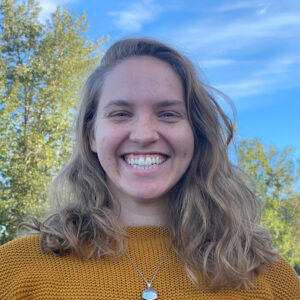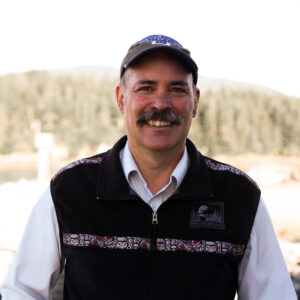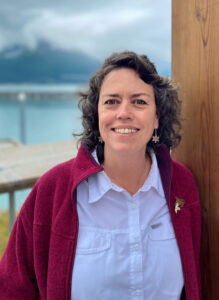
By Maia Draper-Reich
Outreach Coordinator
In April, Project Manager Danielle Verna and I were able to fly out to visit Ouzinkie, Alaska, thanks to clear weather and Council Board member Elijah Jackson. Jackson, who is the Kodiak Island community’s Mayor and Village Public Safety Officer, hosted us for a day connecting with community members of all ages.
First, we stopped by the Ouzinkie School, which has two small mixed-age classroom groups: Kindergarten-5th grade and 6th-12th grade. We spent time with each class teaching our Critter Clean Up lesson, a hands-on activity that allows students to learn about wildlife clean up during an oil spill. We discussed the Exxon Valdez oil spill, why the Council exists, and the work that we do. Then, the students experimented with different cleaning solutions using a faux bird feather to learn about the challenges of caring for oiled wildlife. The students had excellent questions and drew connections to their coastal community and the wildlife that live there.
Midday, the Council co-hosted a community reception at the Tribal Cultural Center with the City of Ouzinkie through Mayor Jackson and his staff. We shared some of the Council’s written materials and publications. Over lunch, which was provided by the Council for those who stopped by, Danielle and I chatted with community members sharing specific Council projects, hearing experiences from the Exxon Valdez spill, and learning their concerns about community preparedness for future spills. Community members were particularly curious about the spill equipment staged in Ouzinkie and logistics for using it during a spill.
We also had time to walk along the waterfront boardwalk, and visit with Mayor Jackson and his staff at the city’s office building. One of the city employees is a cat – in charge of pest control for the office.
In addition to our day in Ouzinkie, while in Kodiak, the Council hosted a booth at ComFish Alaska 2025, a commercial fishing trade show held every year. The event also features a series of forums and presentations including discussions with Alaska’s federal and state legislators. At the booth, Board members Aimee Williams, who represents the Kodiak Island Borough, and Wayne Donaldson, who represents the City of Kodiak, connected with Kodiak community members sharing the Council’s work. We heard stories from community members involved in aftermath of the Exxon Valdez oil spill and the formation of the regional citizens advisory councils in Prince William Sound and Cook Inlet.
I am grateful to be able to connect with our downstream community members, to share information and to hear their perspectives, including with the next generation of stewards of these lands and waters.



